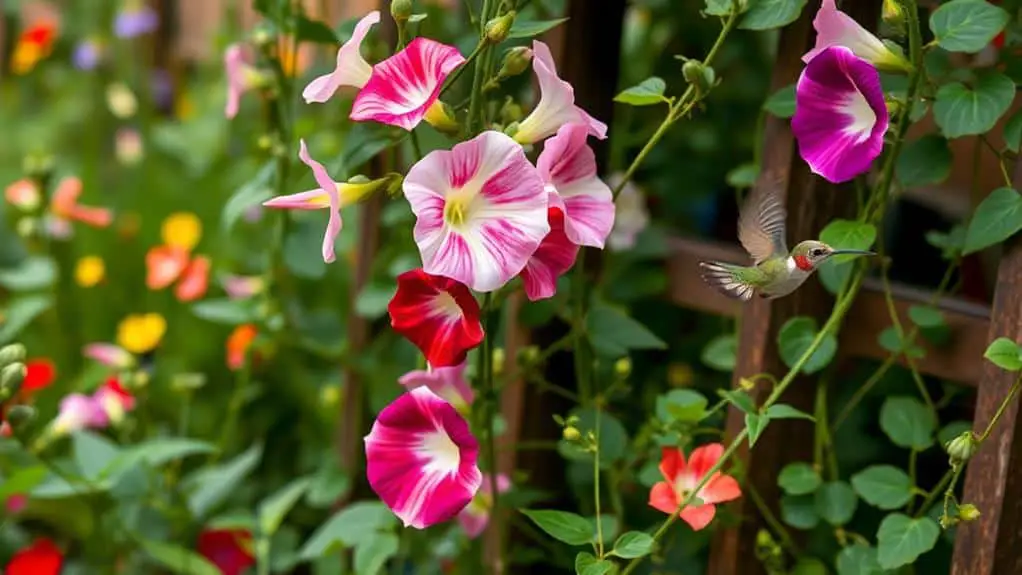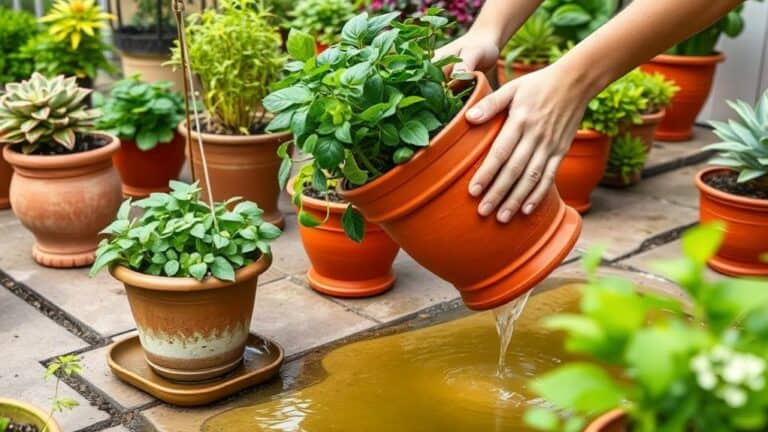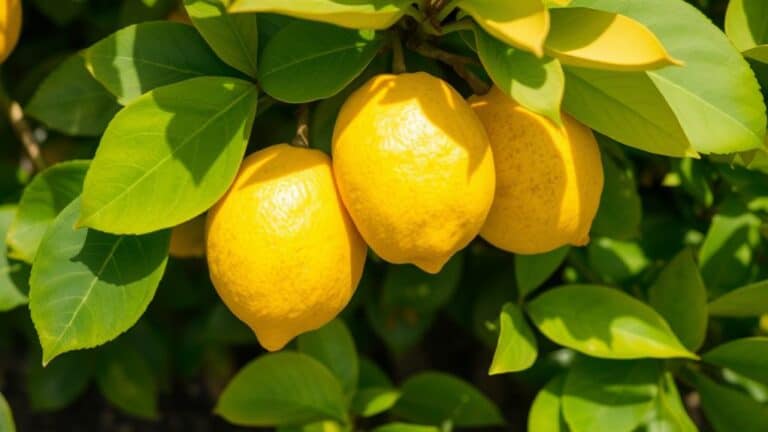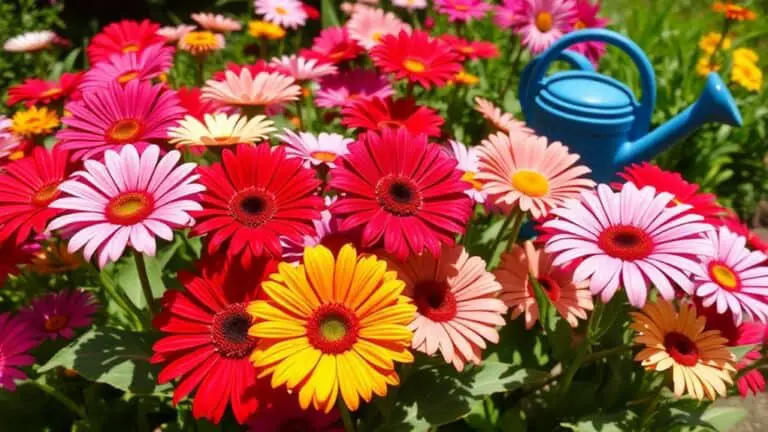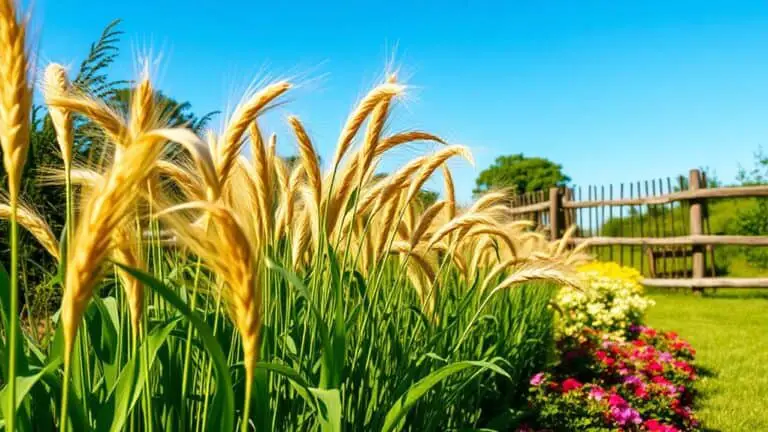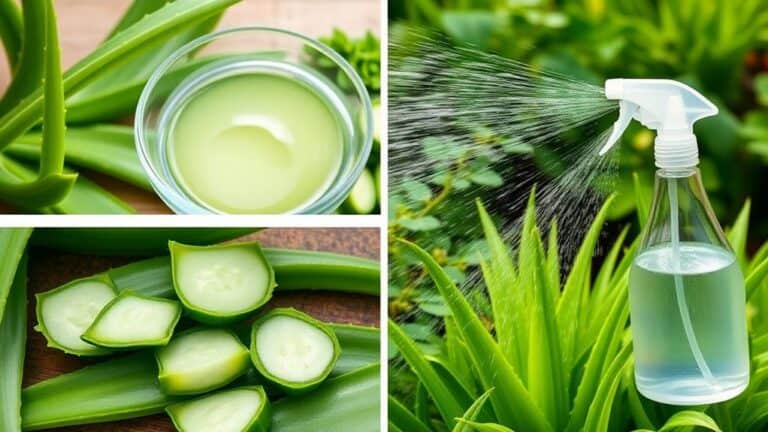Morning Glory Flowers Attract Hummingbirds But Can Be Invasive
I've always admired morning glory flowers for their vibrant hues and the way they effortlessly draw hummingbirds into our gardens. Yet, I can't help but notice how quickly they spread, sometimes choking out other plants. It's a bit of a double-edged sword—while they're fantastic for attracting pollinators, their invasive nature can cause real issues. Have you ever wondered how to keep the beauty of morning glories without letting them overrun your garden? There's an interesting balance to strike, and it's worth exploring.
Characteristics of Morning Glories
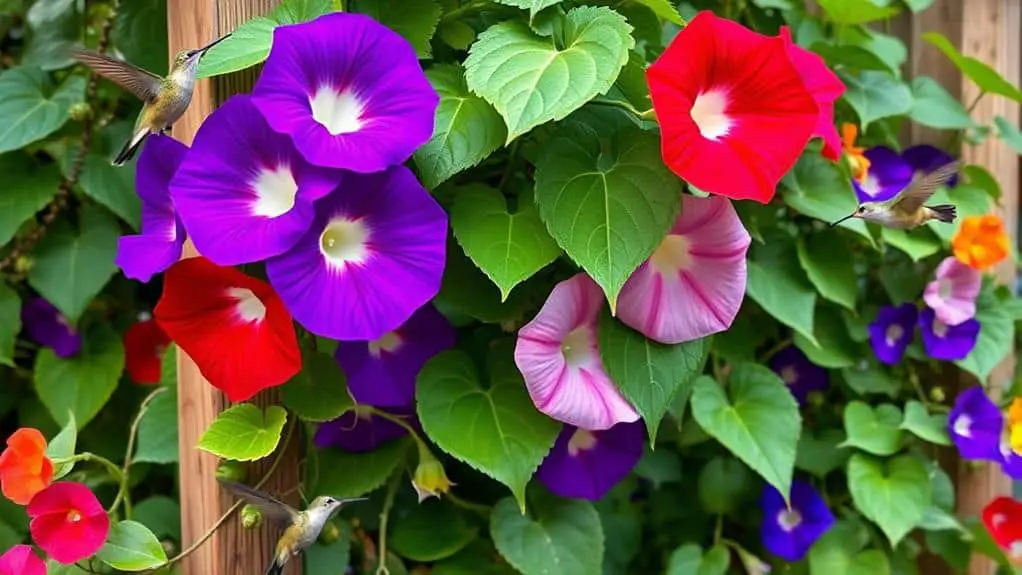
When it comes to garden vines, morning glories stand out for their rapid growth and vibrant blooms. These fast-growing morning glory vines can grow over 10 feet in a single year.
Their flowers come in stunning shades of red, blue, pink, and purple, making any garden look beautiful. However, you should know that many species, like Ipomoea purpurea and Ipomoea coccinea, are considered noxious weeds. They can reseed easily and outcompete native plants.
Morning glories need full sun and well-drained soil, with at least six hours of sunlight daily. While they add aesthetic appeal, their invasive nature requires careful management.
With some attention, you can enjoy their beauty without letting them take over.
Attracting Hummingbirds
How can you create a garden that attracts hummingbirds? Start by planting morning glory flowers, like Ipomoea purpurea. These flowers are rich in nectar, making them irresistible to hummingbirds. Their tubular shape is perfect for the birds' long beaks. Morning glories can grow over 10 feet, offering plenty of feeding opportunities, especially during migration.
| Plant Name | Attracts Hummingbirds | Invasive Potential |
|---|---|---|
| Morning Glories | Yes | High |
| Trumpet Vine | Yes | Low |
| Coral Honeysuckle | Yes | Low |
| Bee Balm | Yes | Low |
| Cardinal Flower | Yes | Low |
For a sustainable garden, consider native plants like trumpet vine or coral honeysuckle. They attract hummingbirds without being invasive, ensuring your garden thrives.
Invasive Growth Patterns

The relentless spread of morning glories represents a significant challenge for gardeners aiming to maintain a balanced ecosystem.
These fast-growing vines can exceed 10 feet in a single season, overshadowing native plants and stealing sunlight and resources. Their ability to reseed prolifically means that even if you plant them in containers, they can still drop seeds that sprout and spread.
In warmer climates, some varieties can survive year-round, making them even more invasive. In colder regions, they die off in winter but can return each year from their seeds.
Once established, they're tough to control because of their aggressive growth and resilience. It's essential to intervene early to manage these invasive plants effectively.
Regional Impact of Invasiveness
In regions where the climate stays warm year-round, morning glories can wreak havoc on local ecosystems. Their invasive nature means they outcompete native plants, leading to significant disruptions.
Let me break it down for you:
- Competition for Resources: Morning glories compete with local flora for sunlight, water, and nutrients.
- Prolific Reseeding: They spread quickly by reseeding, which complicates efforts to manage them.
- Impact on Biodiversity: They can overshadow and kill native plants, altering the area's biodiversity.
In colder regions, morning glories are more manageable because they die off in winter.
However, in warmer zones, their year-round growth can lead to classification as noxious weeds in some states. Always check local guidelines before planting!
Native Plant Alternatives
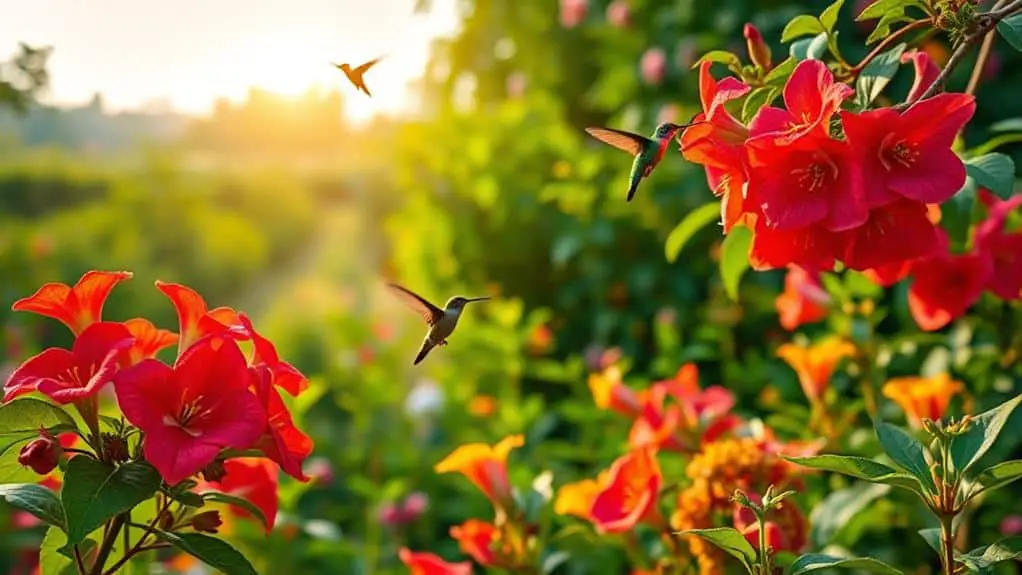
Let's talk about some native plants that can replace morning glories and still attract hummingbirds.
Options like trumpet vine, coral honeysuckle, passionflower vine, and crossvine offer beautiful blooms and support local wildlife.
Native Flowering Vine Options
You might be tempted by the allure of morning glories, but native flowering vines offer a more sustainable and ecologically beneficial choice for your garden.
A native vine to evaluate is the trumpet honeysuckle (Lonicera sempervirens). It's hardy in zones 4-9 and attracts hummingbirds without being quite invasive.
Crossvine (Bignonia capreolata) is another excellent choice for zones 6-9, offering vibrant blooms and supporting local biodiversity.
Here are three native flowering vines you might love:
- Trumpet honeysuckle: Thrives in zones 4-9, attracts hummingbirds.
- Crossvine: Hardy in zones 6-9, vigorous growth.
- Native passionflower: Zones 5-9, unique blooms, edible fruit.
These native options help promote ecological balance and support local wildlife.
Benefits of Local Flora
When we choose native flowering plants like trumpet vine (Campsis radicans) and coral honeysuckle (Lonicera sempervirens), we're not just adding beauty to our gardens; we're making a powerful ecological choice.
Native plants provide essential nectar for hummingbirds and support local ecosystems. They usually need less maintenance and resist local pests and diseases better than non-native species.
By reducing competition with local flora, native plants promote a balanced ecosystem and preserve natural habitats for wildlife. Research shows that native plants attract more pollinators, making gardens healthier and more productive.
Sustainable Gardening Practices
Building on the benefits of local flora, sustainable gardening practices take this a step further by focusing on native plant alternatives that actively support hummingbirds and other wildlife.
Plants native to the U.S., like trumpet vine and coral honeysuckle, attract hummingbirds while boosting local ecosystems. Sustainable gardening practices mean choosing these plants to avoid invasive species and their risks.
Here are three benefits:
- Biodiversity: Using native plants like bee balm and salvia enhances garden biodiversity.
- Eco-Friendly: Native plants reduce the need for chemical pest control.
- Community: Educating others about native plants promotes sustainable gardening.
Sustainable Gardening Practices
To create a sustainable garden that attracts hummingbirds, I recommend planting native flowers like trumpet vine or coral honeysuckle.
These plants support local ecosystems and help prevent the spread of invasive species.
Using containers and barriers can also control plant growth, making it easier to manage your garden's health.
Native Plant Choices
Exploring sustainable gardening practices, we can make a significant impact by choosing native plant alternatives to morning glories. Not only do these native plant choices support local ecosystems, but they also attract hummingbirds and other pollinators.
For instance, honeysuckle (Lonicera sempervirens) and trumpet vine are excellent options.
Here's why native plants are beneficial:
- Biodiversity: They provide habitats and food for local pollinators.
- Low Maintenance: Native plants are well-suited to local climates, reducing upkeep.
- Continuous Blooms: Perennials like bee balm and cardinal flower guarantee flowers all season long.
Incorporating these plants into your garden can make it both beautiful and sustainable.
Let's work together to foster environments that support our local wildlife!
Controlling Plant Spread
Morning glory flowers, with their vibrant blooms and vigorous growth, can quickly turn from a gardener's delight to a persistent nuisance if not managed properly.
To keep Morning Glories in check, I monitor them regularly. They can drop seeds easily, leading to unwanted growth.
I use physical barriers like landscape fabric or deep-edged containers to limit their spread and prevent roots from escaping. Regular pruning helps control their size and stops them from overshadowing native plants.
I also make it a habit to manually remove any new seedlings before they mature.
Educating yourself and your neighbors about their invasive nature is key. By working together, we can manage and enjoy these beautiful but vigorous plants responsibly.
Managing Morning Glories
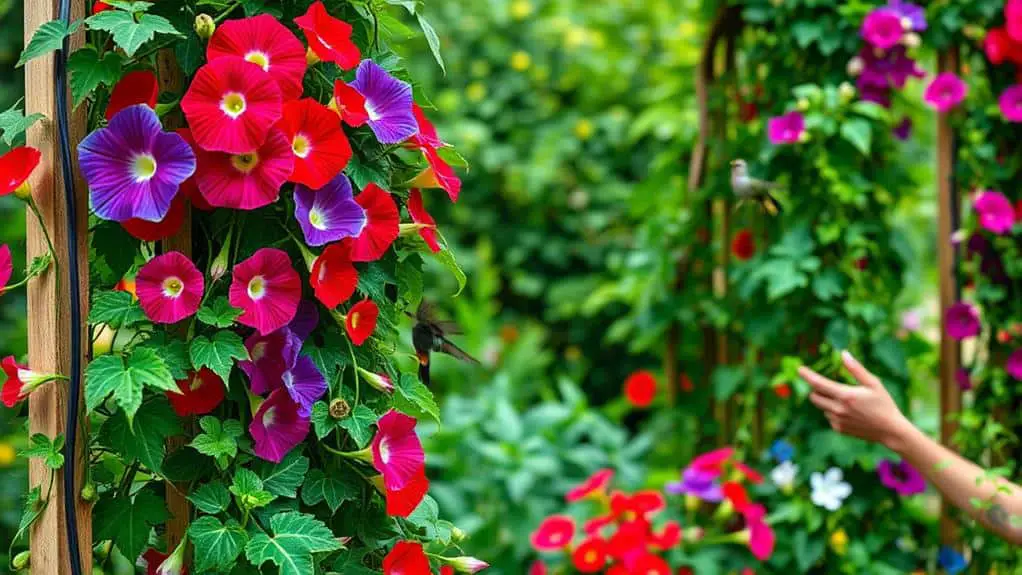
Dealing with the rampant growth of morning glories requires a proactive approach to keep them from taking over your garden.
To manage these fast-growing vines, I've found it helpful to follow a few key steps:
- Pull up the vines early: Removing them before they produce seeds stops their spread.
- Monitor growth regularly: Morning glories can grow over 10 feet a year, potentially smothering native plants.
- Use barriers or containers: These can limit their spread, especially in warmer climates where they can become perennial.
Benefits of Native Vines
Choosing native vines for your garden brings a host of benefits that extend beyond just adding beauty.
Native vines, like trumpet vine and honeysuckle (Lonicera sempervirens), provide essential nectar sources for hummingbirds while supporting local ecosystems.
These plants are naturally resilient to local pests and diseases, so you won't need many chemical treatments to keep them healthy.
Plus, they grow harmoniously with local flora, reducing competition for resources and promoting a balanced ecosystem.
Pollinator-Friendly Gardens
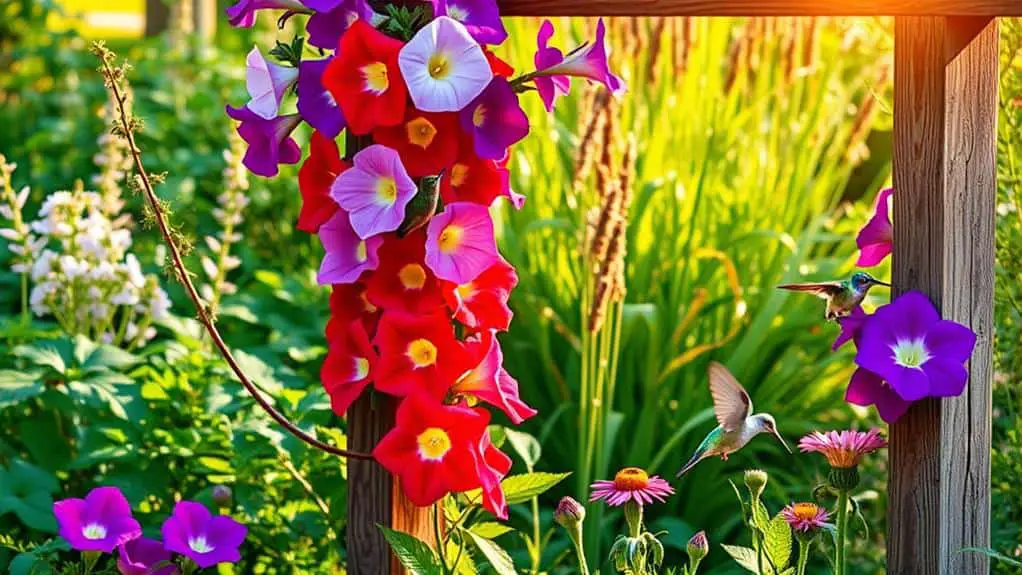
Creating a pollinator-friendly garden isn't just about adding beauty to your space—it's about fostering a vibrant and balanced ecosystem.
By incorporating native plants like trumpet vine and coral honeysuckle, you can provide essential nectar sources for hummingbirds and other pollinators without the invasive risks.
Here are three steps to get you started:
- Choose Native Plants: Native species can perennialize and support local ecosystems.
- Plan Bloom Times: Select plants that bloom at different times to guarantee a continuous food supply.
- Monitor Growth: Regularly check your garden to manage plant growth and prevent invasive species from taking over.
Community Awareness
While establishing a pollinator-friendly garden, it's equally important to raise awareness in our community about the impact of invasive species like morning glories.
Community awareness is essential since these plants can outcompete native flora and disrupt local ecosystems. Educating our neighbors about the potential for morning glories to reseed and spread helps manage their growth in shared spaces.
We should communicate local regulations to prevent illegal planting where they're considered noxious weeds. Organizing workshops and informational sessions can promote native alternatives that attract hummingbirds without the invasiveness.
Engaging community members in monitoring and reporting morning glory spread fosters collective efforts to protect our local biodiversity.
Together, we can make a significant difference.
Frequently Asked Questions
Can Morning Glories Be Invasive?
Yes, morning glories can be invasive. In my experience, managing morning glory care is tricky due to their rapid growth. Some morning glory varieties reseed prolifically, overshadowing native plants and complicating garden management. Use caution when planting.
Do Morning Glory Flowers Attract Hummingbirds?
Absolutely, morning glory flowers attract hummingbirds. I've seen them feeding on the rich nectar, enhancing both garden aesthetics and ecosystem health. Their vibrant blooms and tubular shape make them irresistible to these fascinating birds.
What Are the Cons of Morning Glories?
Maintaining morning glories is tough. They grow rapidly, outcompete native plants, and can cause potential allergies. They reseed prolifically, creating unwanted overgrowth. In warmer climates, they survive year-round, increasing competition and disrupting local ecosystems.
How Do I Get Rid of Invasive Morning Glories?
To get rid of invasive morning glories, I regularly pull the vines and use mulch or landscape fabric for prevention. Selective herbicides can help too. Consistent monitoring and removing new seedlings are essential removal methods and prevention strategies.
Conclusion
So, while morning glories are beautiful and great for attracting hummingbirds, they can also be pretty invasive. It's important to manage them so they don't take over your garden. Try mixing in some native plants to keep a good balance. Remember, you can create a lovely, pollinator-friendly garden without letting any one plant dominate. With a bit of effort, you'll have a thriving garden that's both beautiful and beneficial for wildlife. Happy gardening!

